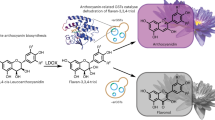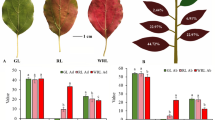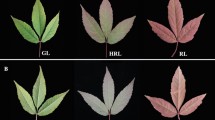Summary
The late block in the biosynthetic pathway to anthocyanin production in the corolla tubes of Antirrhinum majus caused by the mutation delila (del) can be circumvented by inoculation with live Botrytis cinerea. Pelargonidin or cyanidin was synthesised depending on the eosinea—Eosinea (Eos) constitution of the host. Other blocks in anthocyanin synthesis have not been overcome in this way. B. cinerea produced tube pigmentation in homozygous pallida-recurrens (pal-rec): del flowers only where pal-rec had mutated to Pal. Inoculation of B. cinerea to the intermediately blocked acyanic homozygous incolorata (inc) : del only initiated synthesis of cyanidin synergistically after administration of the absent dihydroflavonol, dihydroquercetin. Corolla tubes of inc Eos : del/inc Eos: del, inoculated and later homogenised and filtered to remove contaminating B. cinerea, initiated synthesis in Inc Eos : del/Inc Eos : del tubes; the heat labile agent was thus transferable from the non-anthocyanin producing acyanic host to one genetically capable of response, where anthocyanin was produced. Since the evidence was against B. cinerea providing an anthocyanin precursor or an enzyme, it is suggested that an enzyme stimulator was either formed in the A. majus corolla tubes or transferred from B. cinerea as a necessary stimulator for the enzyme that enabled the elaboration of the dihydroflavonol to anthocyanin.
Similar content being viewed by others
Article PDF
References
Deverall, B J. 1976. Current perspectives in research on phytoalexins. In Biochemical Aspects of Plant-Parasite Relationships, ed. J. Friend and D. R. Threlfall. Annual Proceedings of the Phytochemical Society, No. 13, pp. 207–223. Academic Press.
Hahlbrock, K, Ebel, J, Ortmann, R, Sutter, A, Wellmann, B, and Grisebach, H. 1971. Regulation of enzyme activities related to the biosynthesis of flavone glycosides in cell suspension cultures of parsley (Petroselinum hortense). Biochim Biophys Acta, 244, 7–15.
Harborne, J B. 1967. Comparative Biochemistry of the Flavonoids. Academic Press.
Harris, J E, and Dennis, C. 1976. Antifungal activity of post-infectional metabolites from potato tubers. Physiol Pl Path, 9, 155–165.
Harrison, B J, and Carpenter, R. 1979. Resurgence of genetic instability in Antirrhinum majus. Mutation Res, 63, 47–66.
Harrison, B J, and Hopwood, D A. 1969. The release of genetically blocked anthocyanin in Antirrhinum majus by Botrytis cinerea. John Innes 60th Annual Report.
Harrison, B J, and Stickland, R G. 1974. Precursors and genetic control of pigmentation. 2. Genotype analysis of pigment controlling genes in acyanic phenotypes in Antirrhinum majus. Heredity, 33, 112–115.
Harrison, B J, and Stickland, R G. 1978. Precursors and genetic control of pigmentation. 4. Hydroxylation and methoxylation stages in anthocyanidin synthesis. Heredity, 40, 127–132.
Onslow, M W. 1925. The Anthocyanin Pigments of Plants, 2nd Ed. Cambridge University Press.
Sampson, D R. 1960. Linkage of a rust-resistance gene with two flower-colour genes in Antirrhinum majus. Can J Genetic Cytol, 2, 216–219.
Stickland, R G, and Harrison, B J. 1974. Precursors and genetic control of pigmentation. 1. Induced biosynthesis of pelargonidin, cyanidin and delphinidin in Antirrhinum majus. Heredity, 33, 108–112.
Vanetten, H D, and Pueppke, S G. 1976. Isoflavonoid phytoalexins. In Biochemical Aspects of Plant-Parasite Relationships, ed. J. Friend and D. R. Threlfall. Annual Proceedings of the Phytochemical Society, No. 13, pp. 239–289. Academic Press.
Author information
Authors and Affiliations
Rights and permissions
About this article
Cite this article
Harrison, B., Stickland, R. Precursors and the genetic control of pigmentation. Heredity 44, 103–109 (1980). https://doi.org/10.1038/hdy.1980.9
Received:
Issue date:
DOI: https://doi.org/10.1038/hdy.1980.9



